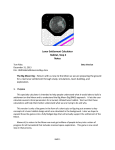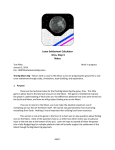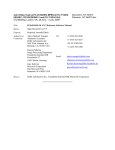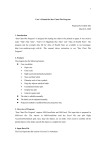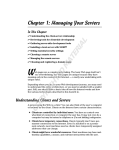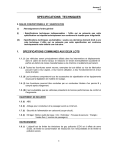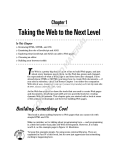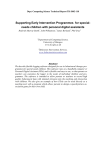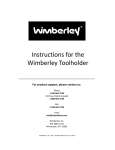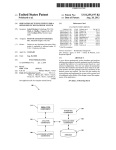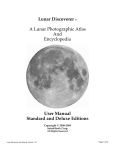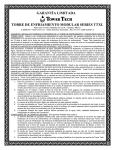Download BMD Lite Games, Step 1 Location Notes
Transcript
Big Moon Dig Lite Games
Step 1, Location
Notes
Beta Version
Tom Riley
January 18, 2014
File: BMDLocationNotesmmddyy.docx
The Big Moon Dig – Return with us now to the Moon as we are preparing the ground
for a real lunar settlement through study, simulations, team building, and
exploration.
1. Purpose
These are the technical notes for the first of the Big Moon Dig lite games. It has the
form of a quiz on the advantages and concerns about various locations for a settlement on the
Moon with emphasis on locations near the south pole. These questions are intended to
improve the player's understanding of the conditions at key locations and the appearance of
the Earth and Sun from the Moon and are in the form of [_] check boxes.
This version is only a lite game in the form of a short quiz on figuring out answers key
concepts of selecting a location for a lunar settlement. Most of the answers have been
calculated in the associated Excel spreadsheet. Later we hope to expand these lite games into a
fully-fledged App that will actually support the settlement of the Moon.
Above all, to return to the Moon we must get millions of people to buy into a vision of
progress for all humankind that includes manned space exploration. This game is one small
step in that process.
BMD 1
2. The Big Moon Dig Way
The Big Moon Dig is a specific approach to problem of humanity returning to the Moon
and building settlements there:
We start with the idea that the human population of the Earth will build to a peak of
about 10 billion around 2050 and then move on to a sustainable Earth. This process will be
difficult, dangerous, and historic. But it will also be exciting, even exhilarating.
Throughout this difficult time, humanity will need visions of positive futures and great
tasks to keep our efforts positive and productive. Space exploration is certainly one of those
great tasks.
We ask the question: On a world of 10 billion people what is your greatest resource?
We answer: 10 billion people!
We also note that if we try to tackle the problems of the 12st century using only the
tools of the 20th century we will surely fail.
Our approach then is to use tools of the 21st century, like the Internet and social media,
to take on one great problem, furthering the human exploration of space. One of our tools is a
complete reorganization of how space exploration is done called a Massive Online Vetted
Exploration (MOVE).
In the 19th century, a few dozen people participated in grand polar expeditions and a
few hundred thousand followed the much delay accounts in the newspapers. In the 21st
century millions of people will participate in grand explorations over the Internet and billions
will follow them near instantaneously through social media.
Our short stories and these lite games are early steps in the MOVE expeditions.
If all that is just a little heavy for you, then let’s just go back to the Moon for the fun of it!
3. General Game Notes
We are not trying to make this game hard; getting back to the Moon has proved hard
enough. You may correct your entries on each question as often as you like by simply making
changes and pressing the [Submit] button again.
Your score for each question is shown with each submission. There is a maximum of 10
points per question but you are penalized both for wrong answers and for failing to check the
right ones.
BMD 2
The name requested is just for reference only and can be an internet nickname or
character name if you prefer. It helps if you keep the same name on all our lite games so that
you can be entered you correctly on our BMD Leader Board.
All the questions in this game are multiple choice with [_] check boxes. Most are
marked "-- [Check all that apply]", but a few are marked "-- [Check one]".
All inputs will be entered with the click of the adjacent [Submit] box. All inputs are then
repeated to the screen so that you can verify what was actually entered. Wrong entries can
simply be replaced and resubmitted.
When you get all your answers to the best of your present ability, you will be
invited to archive the result. This simply means your result will be automatically e-mailed to
The Big Moon Dig when you click the [Submit] button. There it will be added to the archive file
and this will make you eligible to be on our BMD Leader Board.
4. Getting Help
The notes below cover most of the quiz material. You can find additional helpful
resources on the Big Moon Dig Site:
•
•
•
•
•
•
The Big Moon Dig home
The Big Moon Dig games
BMD Lite Game on Lunar Locations
An Excel spreadsheet with all the calculations and source data for this game
o in .pdf
o in .xlsx
Graphics of settlements and equipment
Stories based on the Big Moon Dig effort
Please contact us through our feedback form if you have any questions.
5. Naming Conventions
By international treaty, the primary system of measurement on the Moon is the System
International (SI), the metric system. All calculations will be done in SI first. The now obsolete
English system value is sometimes provided in parentheses.
BMD 3
For historic reasons, and again by international agreement, human habitations off Earth are
always referred to as “settlement” and never “colony”. One only has to think back to the
American Revolution to appreciate the terrible baggage the word "colony" carries.
Few mountain tops on the Moon have formal names. The peaks are commonly given the
name of the nearest named crater, for example Mt. Malapert. Large blocks of curst which can
contain multiple peaks or plateaus are called massif, for example Scott Massif. Again they are
named for the nearest named crater.
When the word "Moon" is capitalized, it refers specifically to Earth's moon as a proper
noun; when it is used in lower case, it can mean any moon. The Moon's other formal name,
Luna, is almost never used. This is a bit sad as the name beautifully refers to a young goddess
who is the huntress of the night. The Sun's formal name is even more neglected, Saul.
Mount Malapert in mid-night sun, by JAXA
6. Prime Locations
The two prime locations under consideration here are Mt. Malapert (85.9 degrees S
Latitude, 0.0 degree E longitude) and the Scott Massif (84.9 degrees S Latitude,12.9 degree E
Longitude). Both are about 120 kilometers from the Moon's southern pole on the Moon's Earth
facing side. Both are remnants of one of the outer rings of the very ancient South Pole-Aitken
Basin.
Both of these sites have not been given formal names so they take their names from the
nearest named craters. Crater Malapert is just north of its mountain and is the most southerly
BMD 4
crater visible from Earth. Crater Scott A is located between its highlands and the south pole
and so is not visible from Earth. Crater Haworth is one of several permanently shadowed
carters in the vicinity which may be accessible from both these sites.
Both sites have several strengths that make them good candidates for lunar settlement
locations:
1. Earth is visible 100% of the time for communication. The mountain top location
improves the view of the Earth from this high latitude.
2. The Sun is visible at least 95% of the time for power generation, thanks largely to the
deep South Pole-Aitken Basin which lies immediately to the south. This advantage is not
available at the Moon's North Pole.
3. Permanently shadowed craters, with known water, are within a few tens of kilometers
of both mountain tops, all be it, by difficult mountain trails. Determining which trail will
be easiest to travel will be one of the most important choice criteria.
4. There are more-or-less flat areas available that are big enough for landing and buildings
sites. Few sites on the Moon are truly flat.
5. Lots of data is available on these sites because polar orbiting satellites pass over them
very often.
There are also a few concerns:
1. Reaching lunar polar location from Earth requires additional rocket burns, or Delta V.
This means a given rocket can deliver less payload.
2. The orbits to reach polar locations are not free return trajectories (think Apollo 13) and
so are not as safe.
3. All mountain top locations on the Moon are not as large or as smooth as many common
lowland locations and so therefore are not as easy and safe for landing.
A key part of the Big Moon Dig games is a contest to decide which of these locations is
best for our dig while not forgetting that new information might bring forward even better
sites. Key questions we will need to answer include:
1.
2.
3.
4.
Which site has the best landing area?
Which site has the best building area?
Which site has the best local solar power schedule?
Which site has the best access to permanently shadowed craters?
7. Size of Disks
Moon:
First we need to better understand some of the peculiarities common to all sites on the
1. Disk of Moon from Earth
2. Disk of Sun from Earth
0.52 degrees, 1/2 a finger at arm's length
0.52 degrees, 1/2 a finger at arm's length
BMD 5
3. Disk of Sun from Moon
4. Disk of Earth from Moon
0.52 degrees, 1/2 a finger at arm's length
1.90 degrees, 1-1/3 fingers at arm's length
Note that the disk of the Earth as seen from the Moon is 3 and 1/2 times bigger than the
disk of the Moon as seen from the Earth. This is simply because the Earth is much bigger than
the Moon. This also means that Earth shine on the Moon can be far brighter than Moon shine
on the Earth.
This also means that eclipses of the Sun by the Earth are very common at all locations
on the Moon. Eclipses occur commonly twice a year, last for tens of minutes, and interrupt
power production while the outside temperature plummets.
8. Location of Earth Disk
The Moon has one face locked to continually face the Earth so the Earth's disk hangs in
the sky on the Moon. How high the Earth hangs in the lunar sky above the horizon is a function
of a site's latitude and altitude.
For the near-polar, mountain top sites we are considering, the Earth will be about 6.7
degrees above the horizon. That is less than one and a half times the width of your hand at
arm's length or the angle of the Sun is in Earth's sky only 30 minutes after sunrise.
As the Moon's orbit is elliptical, the Earth will appear to follow a small figure eight
course during the year but never moving away from the mean position by more than its
diameter.
The Earth will also go through phases over the course of the month long lunar orbit. It
will be full when the Sun is lowest and to the south at midnight. The Earth disk will be nearly
dark at noon with the Sun passing behind it. At all times the amount of Earth shine will be
sensitive to the cloud cover on the illuminated part of Earth's disk.
Above all the Earth will look very big indeed. There is even an optical illusion that makes
the Moon's disk look bigger when near the horizon that will be in play.
BMD 6
9. The Path of the Sun
As with all arctic locations, on both the Earth and Moon, the sun follows a path always
low to the horizon, summer and winter, day and night. The Sun is clearly higher at noon, but
nowhere near what one expects if one is raised at lower latitudes. At midnight the sun is
always much closer to the horizon and depending on the location, may even vanish below it.
The Sun simply goes around and around near the horizon every 27.2 Earth days.
The Moon's orbit is tipped about 5 degrees with respect to Earth's orbit around the Sun,
called the ecliptic. This means that the angle of the Sun as seen from any point on the Moon
can vary quite a bit over the year. Fortunately this figure can be calculated with great accuracy
(but not on a simple spreadsheet).
At the near South-Polar lunar locations we have a special consideration. The SouthPole/ Aitken Basin is so deep that the midnight sun is above the horizon most of the time. This
produce the "peak of eternal light" effect and is of great advantage for generating power at
these locations.
10. Two Shadows
The lighting at any location on the Moon is tricky but very important in operating rovers.
. The lighting at near polar locations is a real puzzle. There are four sources of light:
1. The Sun -- The only source of real power and warmth.
2. Earth Shine -- Often this can be much brighter than Moon shine on Earth and can
provide enough light for cameras to work.
BMD 7
3. Moon Shine from the surface as a diffuser -- The surface of the Moon is about the
color of an old parking lot. When the Sun shines directly some light is scattered back
producing Moon shine. The direction of scatter is called Bidirectional Reflectance
Distribution Function (BRDF) has the general shape of a cosine. Very little light is
scattered to other locations near the ground but the side of a nearby hill, if well
illuminated by the Sun, can provide considerable light.
4. Starlight -- If all other light is blocked then there is always star light.
The result is two distinct shadows which can have varying degrees of darkness and
sharpness of the edges. The Sun shine shadow is always low and long. The Earth shine shadow
is also long but much weaker to the point of sometimes fading away, but always in a fixed
direction. When both are strong they form something like the hands of a clock.
Only the direct Sun shine can provide power and heat. All the others combined can
provide only a trickle of power and little heat at all. Direct Sun almost always comes in at step
angles less the 15 degrees. This radically effects the design of solar panels. The panels need to
be stood up vertically and rotated once a month to follow the Sun. Furthermore, the higher the
solar panel is up its pivoting pole, the better it can work by seeing over the long shadows of
local rocks and bumps.
This is a very different rover than one designed for Mars.
11. Communication Speed with Earth
Electronic communication times between the Earth and the Moon can cause problems. A
typical two way communication for anywhere on Earth might typically take:
1. Equipment Delay on Moon, 4 msec typical
BMD 8
2.
3.
4.
5.
6.
7.
8.
9.
Moon to Earth transmission at speed of light , 1.28 sec
Equipment delay on Earth, 4 msec typical
Earth to Geostationary Satellite, 0.12 sec
Equipment delay on satellite, 4 msec typical
Satellite to Earth, 0.12 sec
Equipment delay on Earth, 4 msec typical
Earth data processing, 10 msec typical
Complete return trip
This is all added up on the accompanying spread sheet to about 2.9 seconds. This is
enough of a delay to cause problems with remote control of robots.
12. Support facilities
Early in its the development of the settlement, we will need a main communication
device on a hill top adjacent to the settlement area. This device will probably be complex and
expensive. It must have the following key features:
1.
2.
3.
4.
5.
6.
Hill top location
Clear view of Earth for microwave and probably laser communication
Lots of cameras, including panoramic, zoom-pan-tilt telescopic, and binocular.
Spinning power panel on a mast
Communication relay for local rovers
Science instruments
We will also need either on this device or on a separate rover:
7. LIDAR system for survey work.
This device will provide the large amount of data needed to support the virtual Moon
described in our stories and games.
~~~***~~~
13. Game Questions
The following game questions are based on the discussion above and the calculation in
the associated Excel Spreadsheet.
Questions:
1. What are the advantages of a settlement location near, but not on, the Lunar SouthPole?
[X] Earth is visible 100% of the
[X] The Sun is visible at least 95% of the time
BMD 9
[X] Permanently shadowed craters are within a few tens of kilometers
[X] There are flat areas available that are big enough for landing
[X] Lots of data is available.
2. What are the concerns about such locations?
[X] Reaching lunar polar location requires additional Delta V
[X] The orbits to reach polar locations are not free return trajectories
{X] Nearly all mountain tops have rough terrain
3. How big is the disk of the Moon as seen on Earth?
[X] 0.5 degree, 1/2 a finger at arm's length
[_] 1.0 degree, 1 finger at arm's length
[X] 1.8 degrees, 1-1/3 finger at arm's length
[_] 4.0 degrees, 1 hand width at arm's length
4. How big is the disk of the Earth as seen on the Moon?
[_] 0.5 degree, 1/2 a finger at arm's length
[_] 1.0 degree, 1 finger at arm's length
[X] 1.8 degrees, 1-1/3 finger at arm's length
[_] 4.0 degrees, 1 hand width at arm's length
5. How does the Earth appear to move as seen from the Moon?
[_] Path near the horizon
[X] Hanging like a stationary picture in the sky over distant mountains
[_] High over head
6. What is the apparent path of the Sun in near polar regions on Earth?
[X] On a circular path hugging the horizon
BMD 10
[_] High over head
7. What is the apparent path of the Sun in near polar regions on the Moon?
[X] On a circular path hugging the horizon
[_] High over head
8. Why can you see the Sun at midnight on some mountain tops in the Moon's southern
polar region?
[X] There is a whacking big hole on the back side
[_] The southern mountains are very high
9. What are the all the good sources of light for small rover cameras on the Moon?
[X] The Sun
[X] Earth Shine
[X] Moon Shine from the diffuse surface
[X] Starlight
[_] Headlamps
[X] Flash lamp
[_] Lasers
10. Of the available sources of light which can provide meaningful heat and power?
[X] The Sun
[_] Earth Shine
[_] Moon Shine from the diffuse surface
[_] Starlight
11. What is the best orientation for a solar panel at a near polar location on the Moon?
[X] Vertical and rotating
BMD 11
[_] Vertical and fixed
[_] Horizontal and fixed
[_] Horizontal and steerable
12. How fast will you need to spin your solar panel through 360 degrees?
[_] Daily
[_] Weekly
[X] Monthly
[_] Yearly
13. Where is water likely to be found on the Moon?
[X] In permanently shadowed craters
[_] Mountain tops
[_] Springs in the valleys
[_] The tropics
[_] Buried water table
14. How do you move your rover down the mountain to find water?
[X] Move from light pool to light pool
[X] While diligently watching the slope
[X] Slowly
[X] Working as a team
[_] Full speed ahead and damn the torpedoes
~~~***~~~
14. Summing Up
BMD 12
We trust you learned something new about the Moon from your work with our Lunar
Settlement Calculator, Step 2. If you have any questions, please contact us through our
feedback form.
Please watch out for additional games and stories on The Big Moon Dig.
___________________________________________________-
Reference Materials
The following books, Web sites, and courses were used for this work:
Books:
1. Tom Riley, Hard Squared Science Fiction, Vol. 01, The Dark of the Moon (e-publication)
2. David Shrunk, Burton Sharpe, Bonnie Cooper, Madhu Thangavelu, The Moon, Resources,
Future Development, and Settlement (Springer, second edition)
3. Harrison H. Schmitt, Return to the Moon, Exploration, Enterprise, and energy in human
settlement of Space (Copernicus, 2006)
4. Ben Bussey, Paul Spudis, The Clementine Atlas of the Moon, (Cambridge, 2004)
5. Michael Light, Full Moon, (Knopf, 1999)
6. Motomaro Shirao, Charles A. Wood, The Kaguya Lunar Atlas: The Moon in High
Resolution (Springer, 2011)
7. Antonin Rukl, Atlas of the Moon, (Sky Publishing, 2004)
8. Robert Godwin, Apollo 16, The NASA Mission Reports, (NASA, 2002)
9. Andy Harris, HTML5 Game Development for Dummies
10. Dug Sahlin, Chris Botello, YouTube for Dummies
11. John Walkenback, Excel VBA Programming for Dummies
12. Ed Tittle, Chris Minnic, Beginning HTML5 & CSS3 for Dummies
13. Aidan Chopra, Google SketchUp 8 for Dummies
14. Andy Rathbone, Windows 8 for Dummies
15. Steven Suehring, Janet Valade, PHP, MySQL, JavaScript & HTML5 for Dummies
16. James Floyd Kelly, Getting StartED with Windows Live Movie Maker
17. Leonard A. Schlesinger, Charles F. Kiefer, Just Start, Take action Embrace uncertainty
Create the Future (Harvard Business Review, 2012)
18. John Berger Contagious, Why Things Catch On (Simon & Schuster 2013)
19. Nassim Nicholas Taleb, The Black Swan: The Impact of the Highly Improbable (Random
House, 2010)
20. Nassim Nicholas Taleb, Antifragile, Things That Gain from Disorder (Random House,
2012)
BMD 13
21. Leslie Grossman, Link Out: How to Turn Your Network into a Chain of Lasting
Connections (Wiley, 2013)
22. Rick Hanson, Hardwiring Happiness, the New Brain Science of Contentment Calm, and
Confidence (Harmony, 2013)
Courses:
23. Chris Stevens, “EwB App Design”, http://apps.excelwithbusiness.com/Home.aspx
24. Karl T. Ulrich, “Design: Creation of Artifacts in Society” (Coursera, University of
Pennsylvania}
25. Eric Rabkin, “Fantasy and Science Faction: The Human Mind, and Our Modern World”
(Coursera, University of Michigan)
Web Sites:
26. “Hard Squared Science Fiction, Vol. 01, The Dark of the Moon”, (Internet)
http://woodwaredesigns.com/EBook/EBook.html
27. “The Big Moon Dig”, (internet) http://bigmoondig/BigMoonDig.html
28. SONO, A world of Knowledge, Infinite Possibilities, (Internet)
http://getsokno.com/redvinef/controllers/login.php
29. “User Manual SONO Platform” (Internet)
http://soknocommunity.com/xoops/docs/UserManual.pdf
30. Tom Riley, “Brain Apps” (Internet) http://bigmoondig.com/Essays/BrainApp.pdf
31. “NDAs for Free” (Internet) http://www.ndasforfree.com/
32. “Moon Base Alpha” (NASA, Internet)
http://www.nasa.gov/offices/education/programs/national/ltp/games/moonbasealpha
/index.html
33. Adrien Treuille “Foldit” (Internet) http://fold.it/portal/
34. “EteRNA” (Internet) http://eterna.cmu.edu/web/
35. ILIADS (LRO data access, NASA, Internet)
http://opensource.gsfc.nasa.gov/projects/ILIADS/index.php
36. Audacity (Sound software, Internet) http://audacity.sourceforge.net/
37. Firebug (debugging software, Internet) http://getfirebug.com/
38. Simple Games Java Script Library, simpleGame.js (Internet)
http://www.aharrisbooks.net,
http://www.aharrisbooks.net/h5g/simpleGamePractice.html
39. Goggle X-Prize Moon (Internet) http://www.googlelunarxprize.org/
40. Lunar Reconnaissance Orbiter, (Internet Wikipedia)
http://en.wikipedia.org/wiki/Lunar_Reconnaissance_Orbiter
41. “TED, Ideas Worth Spreading,”, [Technology Engineering Design] (Internet)
http://www.ted.com/
42.
BMD 14














